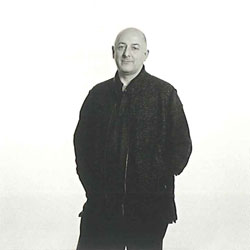João Penalva
João Penalva Lisboa ¶ 1949
 |
|
| Créditos fotográficos / Photographic credits: Abílio Leitão |
His first artistic career was that of a dance interpreter, from 1968 to 1976, and his studies in the area guided him through Paris, Lisbon and London. He was a member of the following companies: Pina Bausch (1973/4), Gerhard Bohner (1975) and his very own, with Jean Pomares (The Moon Dance Company, 1976). With a residency in London from 1976 onwards, he commenced a career in the visual arts field, as soon as he was accepted in the Chelsea School of Art. ¶ He started with paintings - regularly exhibited in Portugal and England since the mid-80s - paintings with a strong compositional element, through the contrasts conveyed by the rhythmic organization of the conflicting surfaces in terms of colour, texture, and image patterns. ¶ In the 90s he turns to site-specific installations and interventions, inaugurating a research chapter in his career that stills continues today. In works such as Arquivos (Archives, 1993) or La chiave a stella (The key to the stars, 1996), both presented in Porto, Penalva evokes the universe of language, of the communication of memories and experiences, through texts, documents, translations, and the very impossibility of translating a text without falling into some degree of imperfection as far as meaning is concerned. One of the most distinctive facets of Penalva's work is the inclusion of letters or texts that relate stories. It adds a new layer to the work presented, adjoining fiction to reality, as in O Cabelo do Sr. Ruskin (Mr. Ruskin's Hair lock, 1997). ¶ As for the videos and films of the last ten years, from 336 Rios (336 Rivers, 1998), to Kitsune o espírito da raposa (Kitsune, the Fox Spirit, 2001) or Mister (1999), the artist singles out characters and stories from the most quotidian of universes and puts them centre-stage, thus granting his works a strong sense of theatricality and narrative, as well as bringing it close to the performance arts scene (Widow Simone-Entracte 20 years, 1996). João Penalva comes forth as an author/character whose distinct mark is his own capacity to reinvent himself, while at the same time showing substantial creative power, whatever the circumstance. ¶ In more recent work, such as Hermitage Pier (2004) and Entre as 2 e as 3 (Between 2 and 3, 2004), the characters have been substituted by the sounds and the movements of the spaces registered by the camera. With no narrative voice, we witness a research on the medium of video. Recently, however, more disturbing, even violent elements have been added, as in Quieto, de pé, pára, não (Still, stand, stop, no, 2005).
http://cvc.instituto-camoes.pt/biografias-en/joao-penalva-2012.html#sigFreeId7d8c794f3f


